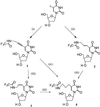Enhancing the catalytic repertoire of nucleic acids: a systematic study of linker length and rigidity
- PMID: 11266559
- PMCID: PMC31265
- DOI: 10.1093/nar/29.7.1565
Enhancing the catalytic repertoire of nucleic acids: a systematic study of linker length and rigidity
Abstract
The incorporation of potentially catalytic groups in DNA is of interest for the in vitro selection of novel deoxyribozymes. A series of 10 C5-modified analogues of 2'-deoxyuridine triphosphate have been synthesised that possess side chains of differing flexibility and bearing a primary amino or imidazole functionality. For each series of nucleotide analogues differing degrees of flexibility of the C5 side chain was achieved through the use of alkynyl, alkenyl and alkyl moieties. The imidazole function was conjugated to these C5-amino-modified nucleotides using either imidazole 4-acetic acid or imidazole 4-acrylic acid (urocanic acid). The substrate properties of the nucleotides (fully replacing dTTP) with TAQ polymerase during PCR have been investigated in order to evaluate their potential applications for in vitro selection experiments. 5-(3-Aminopropynyl)dUTP and 5-(E-3-aminopropenyl)dUTP and their imidazole 4-acetic acid- and urocanic acid-modified conjugates were found to be substrates. In contrast, C5-amino-modified dUTPs with alkane or Z-alkene linkers and their corresponding conjugates were not substrates. The incorporation of these analogues during PCR has been confirmed by inhibition of restriction enzyme digestion using XBAI and by mass spectrometry of the PCR products.
Figures





References
-
- Breaker R.R. and Joyce,G.F. (1995) A DNA enzyme with Mg2+-dependent RNA phosphoesterase activity. Chem. Biol., 2, 655–660. - PubMed
-
- Cuenoud B. and Szostak,J.W. (1995) A DNA metalloenzyme with DNA-ligase activity. Nature, 375, 611–614. - PubMed
-
- Lorsch J.R. and Szostak,J.W. (1994) In-vitro evolution of new ribozymes with polynucleotide kinase activity. Nature, 371, 31–36. - PubMed
-
- Santoro S.W., Joyce,G.F., Sakthivel,K., Gramatikova,S. and Barbas,C.F. (2000) RNA cleavage by a DNA enzyme with extended chemical functionality. J. Am. Chem. Soc., 122, 2433–2439. - PubMed
-
- Zhang B.L. and Cech,T.R. (1997) Peptide bond formation by in vitro selected ribozymes. Nature, 390, 96–100. - PubMed
Publication types
MeSH terms
Substances
Grants and funding
LinkOut - more resources
Full Text Sources
Other Literature Sources
Miscellaneous

